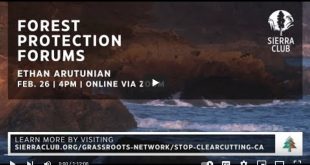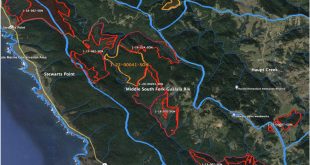Why is this a conservation priority
for Friends of the Gualala River?
After the massive clear-cutting of the 1950s and 1960s removed most of the old growth forest cover from the lower Gualala River watershed, a large residue of fallen old-growth logs (“buckskins,” or downed large woody debris) remained. Dead standing mature trees and deformed trees (snags, “wolf” trees) were often left behind because they were not commercially valued at the time.
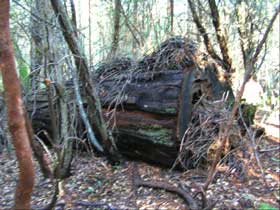
|
Modern forest ecologists recognize that the old-growth logs left behind during the 20th century are ecologically important “structural legacies” of old-growth forests that provide highly important habitat structures for terrestrial and aquatic wildlife. The leftover large woody debris from old clear-cuts enables many species associated with mature forest habitats to persist where they would not otherwise be able to tolerate young cut-over forest conditions.
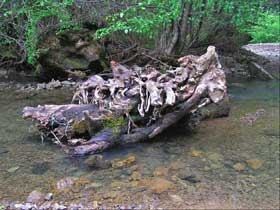
|
Large old-growth woody debris takes many centuries to form: it requires massive trees to grow and die. Old growth redwood logs are very slow to decay, and provide stable habitat for very long periods of time. Compared with trees grown on 30 or 40 year forest rotations of harvest, they are irreplaceable.
Some industrial timber companies have policies to harvest forest products sustainably. They acknowledge that large woody debris is
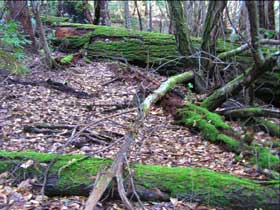
|
ecologically valuable and infeasible to replace. The Forest Stewardship Council (FSC), which certifies the forest industry for “sustainable harvested” wood, maintains minimum standards for large woody debris in Pacific coastal forests, and offers goals for recruiting stocks of large downed wood.
Beyond this, some industrial timber companies have policies to forsake potential profits of harvesting and milling redwood “buckskins” so that large woody debris habitats are maintained in second-growth forests. [See Mendocino Redwood Company’s Old Growth Policy and Modeled Silviculture Regimes].
In contrast, in Annapolis (northwestern Sonoma County), Friends of the Gualala River (FoGR) is concerned about expansion of
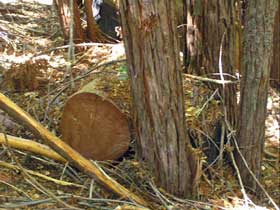
|
relatively new commercial forest product harvesting and manufacture operations that target downed large old-growth redwood logs. The fine-grained, decay-resistant wood of old-growth logs is prized for furniture manufacture, and commands very high market prices. As the market value of old-growth wood has increased, so has commercial pressure to extract the old-growth legacies of downed wood in the coastal forestlands of the Gualala River.
FoGR considers the harvest of large old-growth redwood logs from the forest floor to be more like mining than forestry – exhaustive, extractive industry, not stewardship. We are appalled that in at least one case, the stripping of large old-growth redwood logs from the forest floor is part of commercial and nonprofit operations that claim to be promoting self-styled “restoration forestry” that will return “Old Growth Again” to former clear-cut forests. We deplore the masquerade of old-growth log extraction industry as “restoration forestry” in an era when even industrial timber companies in our region have committed to conserve downed old-growth redwood legacies.
Why are old growth redwood logs
(“large woody debris”) important
to forest and watershed health?
Citations
“Redwood forests are more than just vast volumes of high-quality wood. They include – along with living trees – standing snags, downed woody debris (decaying logs and branches) and a myriad of plant, fungal and animal species that make use of these habitat components. In addition, redwood trees may last as long as logs as they do as living stems, so both are important components of ecosystem structure and function.”
“Stand history appears to be crucial in determining the amount of woody debris present today in many areas. On many private lands, downed logs are removed as soon as they have fallen from accessible parts of old-growth stands or cut on the site for shakes and other products.”
Sawyer, J.O., S. C. Sillett, J.H. Popenoe, A. LaBanca, T. Sholars, D.L. Largent, F. Euphrat, R.F. Noss, and R. Van Pelt. 2000. Characteristics of redwood forests. Pp. 39-80 in: Noss, Reed F. 2000. The Redwood Forest: History, Ecology, and Conservation of the Coast Redwoods. Island Press, Washington D.C.
“Similarly, species that rely on snags and coarse woody debris, such as many salamanders, also do not occur or persist in young forests, unless considerable woody debris (“biological legacies”) remains from the old growth that formerly occupied the site… Furthermore, most of the 320 species of fungi found in redwood forests depend on coarse woody debris – large, downed logs that retain moisture in the dry season.”
Sawyer, J.O., S. C. Sillett, W. J. Libby, T.E. Dawson, J.H. Popenoe, A. LaBanca, T. Sholars, D.L. Largent, R. Van Pelt, S.D. Veirs Jr. R.F. Noss, D.A. Thornburgh, and P. Del Tredici. 2000. Redwood trees, communities, and ecosystems: a closer look. Pp. 81-118 in: Noss, Reed F. 2000. The Redwood Forest: History, Ecology, and Conservation of the Coast Redwoods. Island Press, Washington D.C.
“Species dependent on specific structural components of old-growth redwood forests (e.g. snags, downed logs, complex canopies of live trees) will decline as these forests are replaced by simplified plantations… Many salamanders, for example, are dependent on coarse woody debris. Plantations and other young, managed forests that retain structural legacies will be expected to retain more species, at least temporarily.”
“The dependence of many terrestrial vertebrates on features of the natural old forest, such as snags, dead and downed woody material, and tree cavities, is well documented in other forests of the Pacific Northwest… What may be less apparent is that many terrestrial vertebrates surviving in managed (i.e., “cutover”) forest stands may be there largely because of the legacies left over from the previous old-growth forest.”
Cooperrider, A., R. Noss, H.H. Welsh Jr, C. Carroll, W. Zielinski, D. Olson, S. K. Nelson, and B.G. Marcot. 2000. Terrestrial fauna of redwood forests. Pp. 119-163 in: Noss, Reed F. 2000. The Redwood Forest: History, Ecology, and Conservation of the Coast Redwoods. Island Press, Washington D.C.
“Woody debris is one of five watershed elements that create and modify stream habitats… Large woody debris consists of large logs that fall into stream channels, either from natural tree death, windthrow, or bank failure, and then play a central role in structuring stream habitats… In the redwood region, large redwood logs can have a dominant influence on stream processes and channel complexity… In headwater streams flowing through old-growth redwoods, nearly all pools are either formed directly or influenced significantly by large organic debris (i.e., logs).”
Welsh, H.H. Jr. T.D. Roelofs, and C.A. Frissell. 2000. Aquatic ecosystems of the redwood region. Pp. 165-199 in: Noss, Reed F. 2000. The Redwood Forest: History, Ecology, and Conservation of the Coast Redwoods. Island Press, Washington D.C.
“Indicators That Might Be Used to Monitor Recovery of Redwood Forests …abundance and density of key structural features (e.g., snags and down logs in various size and decay classes)…”
Thornburgh, D.A., R.F. Noss, D.P. Angelides, C.M. Olson, F. Euphrat, and H.H. Welsh Jr. 2000. Managing redwoods. Pp. 229-261 in: Noss, Reed F. 2000. The Redwood Forest: History, Ecology, and Conservation of the Coast Redwoods. Island Press, Washington D.C.
“Several species commonly associated with old-growth forests in the Pacific Northwest, including the northern spotted owl, can be found in second-growth redwoods. Apparent explanations for this phenomenon include the rapidity with which young redwoods can reach reasonably large size, and the presence in second-growth forests of biological legacies (snags and downed logs) from the former old-growth forest… and as the biological legacies decay over time, habitat suitability for old-growth species can be expected to decline.”
Noss, R.F. 2000. Lessons from the redwoods. pp. 263-268 in: Noss, Reed F. 2000. The Redwood Forest: History, Ecology, and Conservation of the Coast Redwoods. Island Press, Washington D.C.
 Friends of Gualala River Protecting the Gualala River watershed and the species living within it
Friends of Gualala River Protecting the Gualala River watershed and the species living within it
